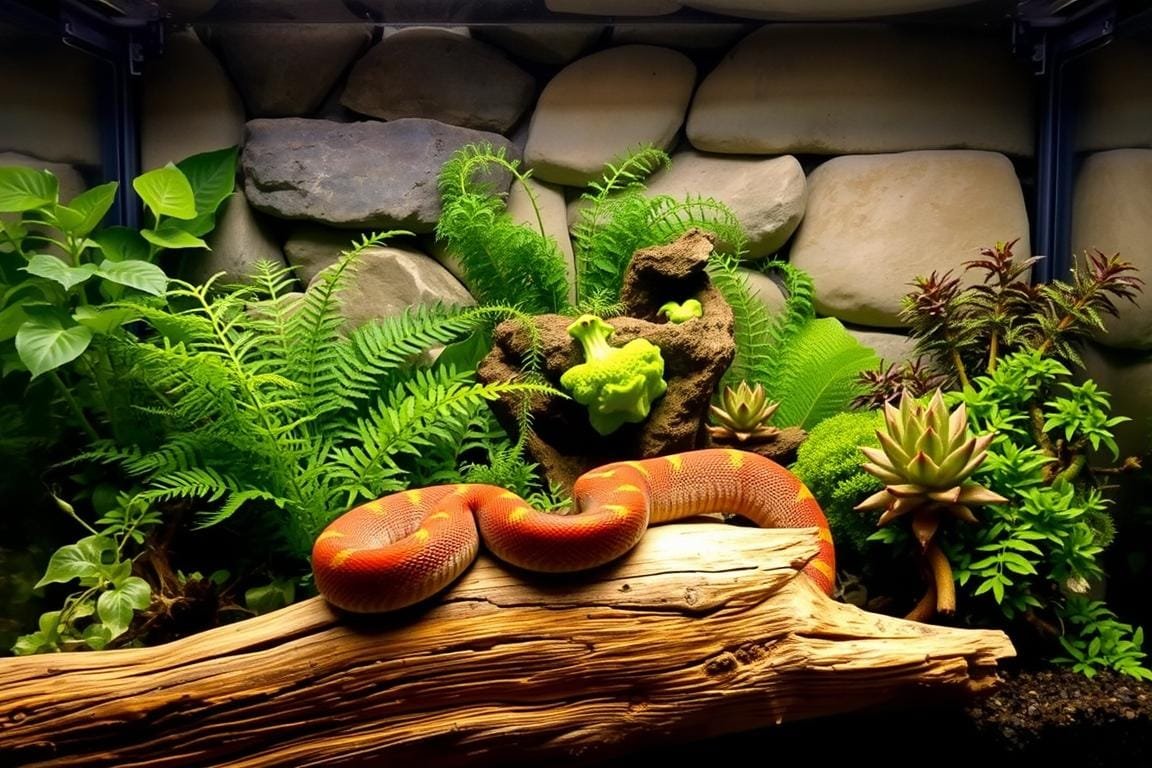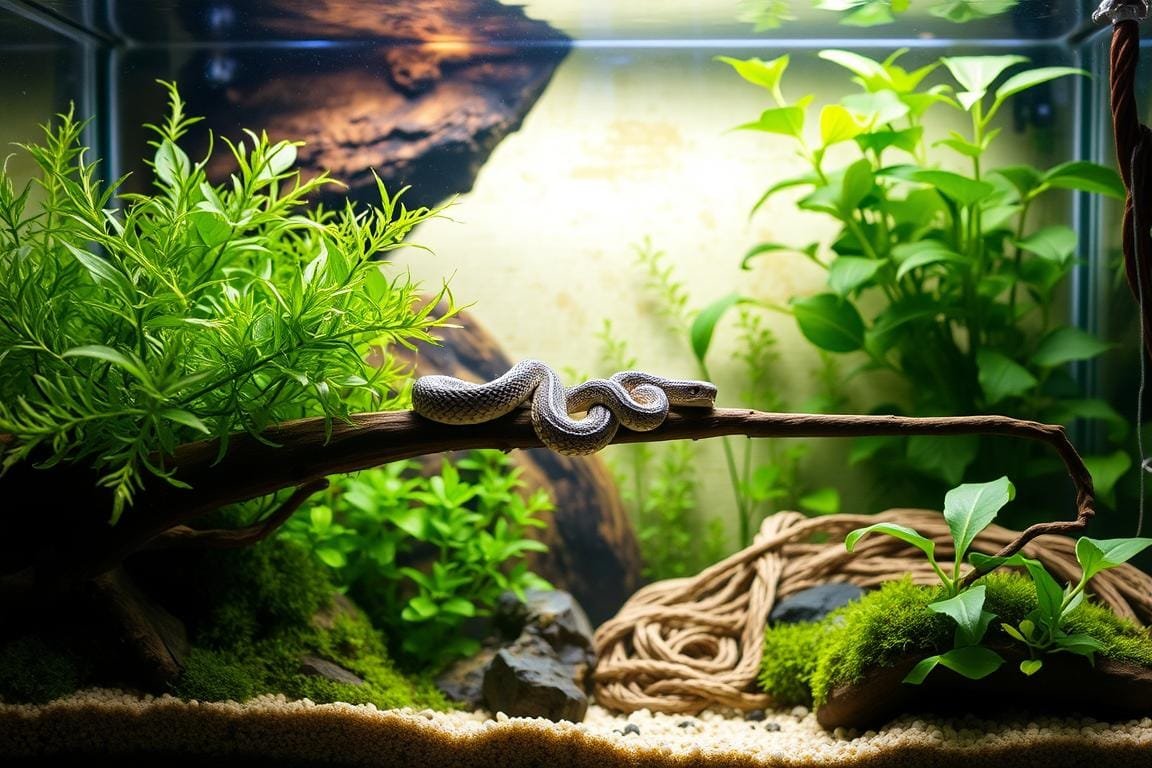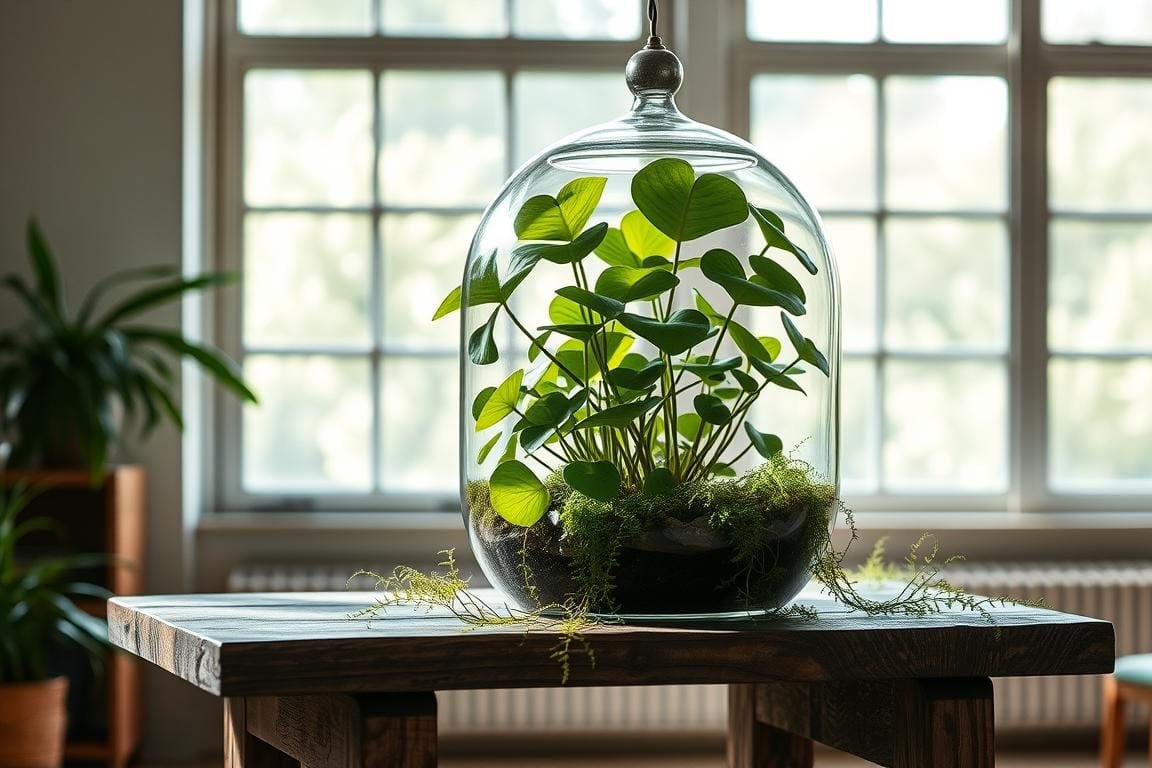Creating a safe and stimulating environment for your reptile companion is essential for its well-being. Adult members of this popular species thrive in enclosures that balance space, security, and naturalistic elements. Proper habitat design not only supports physical health but also encourages natural behaviors like exploration and thermoregulation.
In the wild, these North American natives inhabit diverse terrains ranging from forests to grasslands. This adaptability means captive environments must offer similar versatility. A well-planned glass terrarium measuring at least 48”L x 24”W provides adequate room for climbing and burrowing while maintaining optimal temperature zones.
Our step-by-step guide covers everything from selecting durable materials to installing precise heating systems. We’ll explore why features like lockable sliding-screen lids – such as those in Zoo Med’s ReptiHabitat™ – prevent escapes while ensuring proper airflow. You’ll also learn how strategic placement of hides and climbing branches creates a dynamic landscape that mirrors natural ecosystems.
Whether you’re a first-time owner or upgrading an existing setup, thoughtful preparation makes all the difference. Let’s dive into creating a habitat that keeps your scaled friend healthy, happy, and engaged with its surroundings!
Selecting the Perfect Enclosure for Your Corn Snake
The foundation of your pet’s health lies in its living space’s design and functionality. Adult specimens require habitats that prevent escapes while offering room to explore. Let’s break down what makes an ideal home for your scaled companion.
Space Requirements and Safety Essentials
Proper sizing ensures your reptile can stretch, climb, and burrow comfortably. Look for front-opening designs with smooth edges to prevent injuries. Zoo Med’s ReptiHabitat™ series offers excellent visibility and durable construction.
Three critical factors when choosing housing:
- Horizontal space for ground movement
- Vertical height for climbing enrichment
- Escape-proof latches to contain curious explorers
| Enclosure Type | Security | Ventilation | Access |
|---|---|---|---|
| Traditional Glass | Medium | Limited | Top-only |
| Modern Terrarium | High | Adjustable | Front doors |
| Custom-built | Variable | Customizable | Multi-panel |
Why Locking Mechanisms Matter
Sliding-screen lids with dual locks provide superior security compared to basic clips. These systems allow easy feeding access while maintaining consistent humidity levels. Many owners report 90% fewer escape attempts with professional-grade locking setups.
For nervous first-timers, pre-assembled kits simplify the process. Experienced keepers can customize using modular components. Either approach creates a safe space that encourages natural behaviors like basking and hide-seeking.
Designing Your 40 Gallon Corn Snake Tank

Crafting an ideal habitat combines smart layout planning with species-specific accessories. Start by dividing the space into three zones: warm basking areas, cool retreats, and moisture-rich hideouts. This approach mimics natural environments while giving your pet options for thermoregulation and security.
Essential Elements for Thriving Pets
Quality hides like Repti Shelter™ or Habba Hut™ provide crucial stress relief. Place one on each temperature end, ensuring snug fits that touch the animal’s body when coiled. For substrate, aspen shavings work well for burrowing species, while coconut fiber maintains humidity for tropical varieties.
Consider these habitat enhancers:
| Accessory | Function | Placement Tip |
|---|---|---|
| Cork Rounds | Climbing surface | Secure vertically |
| Moss Pads | Humidity control | Near water dishes |
| Artificial Plants | Visual barriers | Around hides |
Glass-front terrariums from brands like Exo Terra® allow clear viewing without compromising security. Leave 30% open floor space to prevent overcrowding – reptiles appreciate room to patrol their territory. Arrange branches diagonally to maximize vertical movement in shorter enclosures.
Test all decor stability before introducing your pet. Wobbly items could cause injury during exploration. Rotate accessories monthly to stimulate mental engagement, creating fresh challenges for curious inhabitants.
Optimizing Heating, Lighting, and Humidity for Your Snake
Creating the right climate in your enclosure ensures your scaled companion thrives. Temperature control and moisture balance work together to support healthy digestion, smooth shedding, and active behavior.
Building Temperature Zones
Start by placing heat sources on one side to create a thermal gradient. Daytime temperatures should range from 75-79°F on the warm end, dropping to 72-75°F at night. Use under-tank heaters paired with overhead lamps for consistent warmth.
| Heat Source | Placement | Temperature Range | Best For |
|---|---|---|---|
| Ceramic Emitter | Above basking spot | 85-90°F | 24/7 heating |
| Under Tank Heater | Warm side base | 75-80°F | Ground warmth |
| Daylight Blue Bulb | Enclosure top | 78-82°F | Daytime cycles |
Lighting and Moisture Balance
Zoo Med’s Daylight Blue Reptile Bulb provides gentle UVB exposure while maintaining natural day/night cycles. Pair with infrared bulbs for nighttime viewing without disrupting sleep patterns.
Keep humidity between 40-60% using these methods:
- Place water dishes near heat sources
- Mist enclosures morning and evening
- Use digital hygrometers for accuracy
For detailed guidance on maintaining proper humidity levels, check our expert resource. Always position thermometers on both ends of the habitat and test equipment weekly. A well-regulated environment keeps your reptile energetic and stress-free!
Creating a Naturalistic Habitat Environment

Transforming your reptile’s enclosure into a slice of wilderness promotes physical activity and mental well-being. Thoughtful substrate choices and strategic decor placement turn sterile spaces into dynamic ecosystems that mirror natural habitats. This approach satisfies instinctual behaviors while making maintenance easier for owners.
Selecting Suitable Substrates and Decor
Three substrate options excel in balancing safety and functionality:
| Material | Moisture Control | Cleaning Ease | Best Use |
|---|---|---|---|
| Aspen Shavings | Low absorption | Spot-clean daily | Dry environments |
| Cypress Mulch | Moderate retention | Full replacement monthly | Humid zones |
| ReptiBark® | High humidity | Stir weekly | Tropical setups |
Layer substrates 2-3 inches deep to support burrowing. Combine with sanitized branches or cork flats for climbing opportunities. Fluker’s Natural Cork Rounds and Zilla Jungle Mix plants create visual barriers that reduce stress.
Arrange decor to leave 40% open floor space – crucial for exercise and thermoregulation. Rotate accessories seasonally using Zoo Med’s care guide recommendations to maintain engagement. Always secure heavy items like slate stones to prevent shifting.
Naturalistic setups benefit both pet and owner. They minimize cleaning frequency through bioactive elements while providing endless exploration opportunities. A well-designed space becomes a living work of art that keeps your scaled friend content and curious!
Feeding and Caring: Beyond the Enclosure Set-Up
Proper care extends far beyond habitat construction. A balanced diet and mental stimulation play vital roles in maintaining your pet’s vitality. Let’s explore how to create lasting wellness through smart nutrition and engaging activities.
Fueling Growth Through Smart Nutrition
Young reptiles need frequent meals to support rapid development. Hatchlings thrive on one pinkie mouse every 5-7 days, while adults require larger prey every 10-14 days. Always choose rodents no wider than your pet’s midsection to prevent digestive issues.
| Age Group | Prey Type | Frequency | Portion Size |
|---|---|---|---|
| 0-6 months | Pinkie mice | Weekly | 1-2g |
| 6-12 months | Fuzzy mice | Every 10 days | 3-5g |
| Adult | Adult mice | Biweekly | 15-20g |
Use stainless steel feeding tongs to avoid accidental bites. Disinfect tools with reptile-safe cleaners after each use. Always provide fresh water in a heavy ceramic bowl – shallow designs prevent spills while allowing easy access.
Enrichment for Active Minds
Stimulate natural behaviors with these habitat upgrades:
- Sphagnum moss tunnels for burrowing practice
- Interchangeable climbing branches
- Scent trails using herb-infused substrates
Rotate accessories weekly to maintain curiosity. Puzzle feeders from brands like Exo Terra® encourage problem-solving during mealtimes. Monitor weight monthly and adjust portions if your companion becomes less active.
Consistent care routines build trust and longevity. Pair proper nutrition with creative challenges to nurture a thriving, energetic companion!
Wrapping Up Your Snake Habitat Setup
Building a thriving home for your scaly friend marks the start of an exciting reptile-keeping journey. By selecting secure enclosures with precise heating zones and natural decor, you’ve laid the groundwork for a healthy, active companion. Remember: quality materials like front-opening terrariums and escape-proof cages make maintenance easier while preventing stress-related issues.
Consistency is key. Check heat gradients daily with digital thermometers and refresh water bowls to maintain humidity. Rotate climbing branches or hides every few weeks to spark curiosity. A well-planned space isn’t just about looks – it supports natural behaviors like burrowing and basking.
Your efforts will pay off in vibrant scales and energetic exploration. Enjoy watching your reptile interact with its carefully crafted environment, knowing you’ve created a sanctuary that mirrors wild habitats. Here’s to many years of shared discoveries and the quiet pride of expert-level care!





